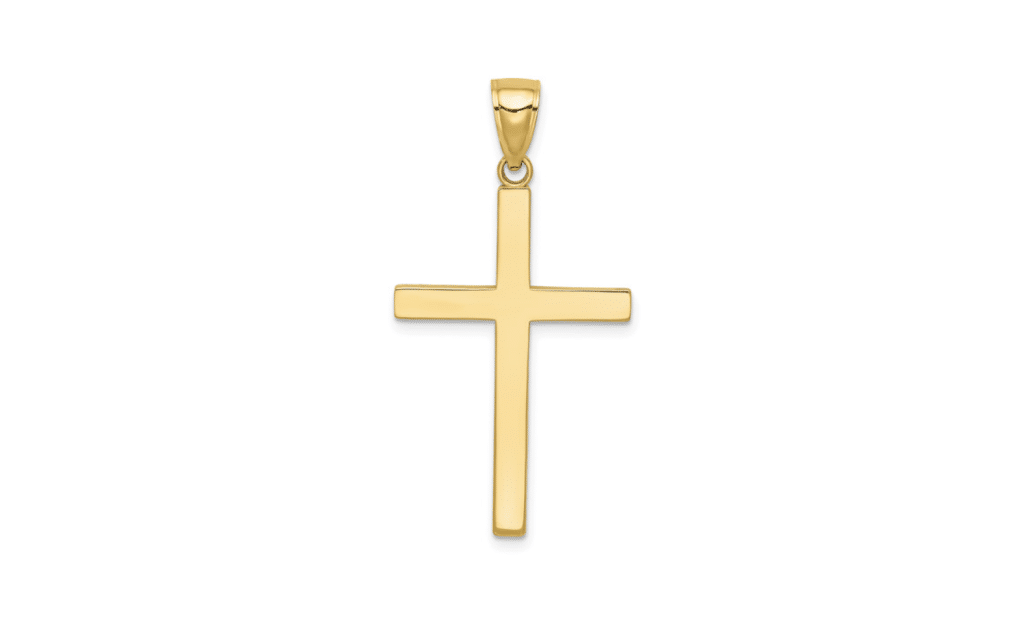In the tapestry of human culture, symbols carry the weight of meaning, history, and identity. Among these, the gold cross stands as a testament to a journey that spans millennia, evolving from a sacred emblem of faith to a ubiquitous staple in the world of fashion. This narrative explores the metamorphosis of gold crosses, tracing their path through time, cultures, and fashion trends to understand how this quintessential symbol has woven itself into the fabric of societal expression.

Origins of the Emblem
The journey begins in the early days of Christianity, where the cross emerged as a powerful symbol of faith, sacrifice, and hope. Initially, it was a clandestine emblem, used discreetly by believers in a time when Christianity was under persecution. As the religion flourished, so did the visibility of the cross, transforming into a prominent symbol of Christian identity and devotion.
The Gold Cross: A Divine Intersection
Gold, with its inherent luster and imperishability, soon became the preferred medium for crafting these crosses. It was not just the metal’s physical qualities but its symbolic resonance—purity, eternal brilliance, and divine favor—that made gold crosses deeply meaningful to their wearers. By the Middle Ages, gold crosses were not merely personal talismans but also markers of status and power, adorned by royalty, clergy, and the devout alike.
The Cross Meets the World of Fashion
The leap from religious artifact to fashion accessory might seem vast, but the gold cross navigated this transition with remarkable fluidity. The Renaissance, with its revival of classical beauty and art, saw the gold cross embellished with gemstones and intricate designs, making it a coveted piece of personal adornment among the elite. This period set the stage for the gold cross’s eventual foray into the broader world of fashion.
Scholarly Perspectives on Symbolism: Insights from Religious Studies Review
The Religious Studies Review offers a scholarly lens through which the gold cross is examined not just as an artifact but as a living symbol that carries deep religious significance and cultural weight. Through the examination of various academic works and articles featured in this review, one gains insight into how the gold cross has evolved in its meaning across different cultures and epochs. This academic discourse enriches our understanding of the gold cross, highlighting its role in religious practices, its significance in personal faith, and its adaptation into a symbol that resonates with a broader audience beyond the confines of strictly religious contexts.
The Modern Metamorphosis
In the 20th century, the gold cross began to detach from its strictly religious connotations, stepping firmly into the limelight of fashion. Icons of style and pop culture adopted the gold cross, infusing it with diverse meanings—rebellion, opulence, spirituality, and fashion-forwardness. Designers, too, played a crucial role, reimagining the gold cross in myriad forms that ranged from minimalist to ornate, making it accessible and appealing to a global audience.
Gold Crosses Today: A Universal Symbol
Today, gold crosses dangle from the necks of individuals from all walks of life, transcending religious, cultural, and social boundaries. They are as likely to be found gracing the runways of high fashion as they are in the quiet corners of personal reflection. The gold cross has become a multifaceted symbol, capable of conveying personal faith, fashion sense, cultural heritage, or even political stance.
Fashion Forward: The CFDA’s Role in Reimagining Religious Icons
The Council of Fashion Designers of America (CFDA) stands at the forefront of integrating timeless religious symbols like the gold cross into the pulse of contemporary fashion. By fostering a community of innovative designers who daringly blend tradition with modern aesthetics, the CFDA plays a pivotal role in how religious icons are perceived and worn in today’s society. Through their advocacy for originality and excellence in fashion design, the CFDA has helped elevate the gold cross from a purely religious emblem to a versatile fashion statement, celebrated on runways and in everyday wear alike. This transformation, championed by the CFDA, not only enriches the fashion industry but also broadens the dialogue between personal belief systems and public expressions of style, making the gold cross a symbol of both personal faith and fashion-forward thinking.
Sustainability and Ethical Considerations
As the gold cross continues to evolve, so does the awareness around the sourcing of gold and the ethical considerations in jewelry production. Consumers and designers alike are increasingly seeking responsibly mined gold, ensuring that the gold crosses of today not only carry a legacy of beauty and symbolism but also of sustainability and respect for the environment and human rights.
The Future of the Gold Cross
What does the future hold for this ancient yet ever-renewing symbol? If history is any indication, the gold cross will continue to adapt, reflecting the changing values, styles, and beliefs of humanity. It may take on new forms, incorporate innovative materials, or return to its roots in simplicity and solemnity. Yet, its core essence will remain—a symbol of connection, whether to the divine, to history, to fashion, or to one’s deepest self.
Beyond a Fashion Statement
The evolution of gold crosses from sacred symbols to fashion staples is a narrative of adaptation and endurance. It showcases the power of symbols to transcend their original meanings, embracing new interpretations while retaining their core essence. In the gold cross, we find a bridge between the past and the present, the sacred and the secular, the personal and the universal. As it continues to adorn the bodies and lives of people around the globe, the gold cross remains a poignant reminder of the enduring human desire to express and connect—making it, indeed, much more than just a fashion statement.
